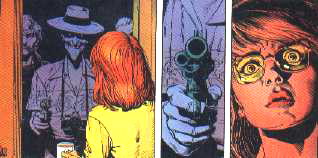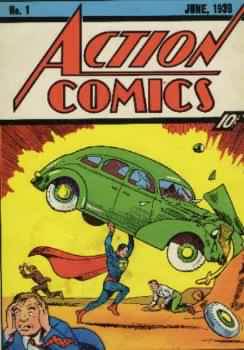|
One
For The Ages:
Barbara Gordon and the (Il)-Logic
of Comic Book Age-Dating
(as
originally appeared in The International Journal
of Comic Art volume 5, issue 2)
Editor's
Note: This is a bit of a change of pace for Once
Upon A Dime. Our stated intent has been to bring
articles from Don and Derek's classic fanzine to
the web. But when noted comics scholar A. David
Lewis offered us this, which he had written for
the International Journal of Comics Art, it was
hard for me to resist. So I asked Don what he thought.
Obviously, he went wild for the piece, too, but
I'll let him tell it.
--
Derek McCaw
Like
most fans of the Golden Age I'm often called upon
to define that age. And that begs the questions
when and where the other ages begin and end. And
how many ages are we talking about? Was there a
period with no age? Well that's for the scholars
to debate.
Then
at the San Diego Con I met A. David Lewis and if
he isn't a scholar I don't know who is. I'm excited
that he asked if we would reprint his article on
the web, though I'm going to disagree with him on
one point: for me, the Golden Age will always end
when Commander Courage Adventures became Courage
To Love in 1954, leaving an "age-vacuum"
until Showcase #4.
--
Donald Swan
 When
undertaking the question of the comic book Ages,
one could look no further than a character from
that selfsame medium, Barbara Gordon, as a guide.
Best known as DC Comics' Batgirl, Barbara Gordon
provides a useful entry point into the discussion
of comic book classification and dating nomenclature.
The heroine long ago hung up her chiropteran tights
out of necessity: a gunshot would to the spine left
the librarian-by-day/vigilante-by-night permanently
paralyzed from the waist down. Moving from the physical
to the cerebral, the paraplegic turned handicap
into opportunity and reinvented herself as Oracle,
remote "freelance information broker who specializes
in metahuman activities" and "the JLA's
secret member" (Morrison, 1998: 1, 75). When
undertaking the question of the comic book Ages,
one could look no further than a character from
that selfsame medium, Barbara Gordon, as a guide.
Best known as DC Comics' Batgirl, Barbara Gordon
provides a useful entry point into the discussion
of comic book classification and dating nomenclature.
The heroine long ago hung up her chiropteran tights
out of necessity: a gunshot would to the spine left
the librarian-by-day/vigilante-by-night permanently
paralyzed from the waist down. Moving from the physical
to the cerebral, the paraplegic turned handicap
into opportunity and reinvented herself as Oracle,
remote "freelance information broker who specializes
in metahuman activities" and "the JLA's
secret member" (Morrison, 1998: 1, 75).
In
this role, she essentially acts as one of the superteam's
most "analytical thinkers" and information
sources (Morrison, 1998: 123). Credited as being
"a genius-level intellect with a near-eidetic
memory and a master in her field" (Howze, 2003)
as well as Wizard magazine's Greatest Super-Heroine
of All Time, Barbara is, to one way of thinking,
both the superhero most emblematic of and the icon
most flattering to the comic book scholar.
With
Barbara in mind as a muse, start with a crucial
scene from her history, that of her crippling in
Alan Moore and Brian Bolland's Batman: The Killing
Joke. She is at home with her father, Gotham
City's Police Commissioner Jim Gordon, as he clips
the latest Joker article for his scrapbook. This
scene follows pages in which Batman occupies his
lair, studying the little concrete information he
himself has on the Joker. In both the case of the
scrapbook and the Batcave database, classic, Golden
Age images of both Batman and the Joker appear,
though the savvy reader knows that these versions
have been overwritten by subsequent decades of creative
teams and retroactive continuity (retcon). With
his sloppy pasteboard system, the Commissioner is
unbothered by this, mainly because he doesn't focus
highly on precise dating: "Look at this one.
First time they met. Now when was that?" (Moore,
1988: 12). Barbara, on the other hand, has an altogether
different approach: "Some day you ought to
let me work out a proper filing system, like we
used at the library" (Moore, 1988: 12).
 In
his book How to Read Superhero Comics and Why, Geoff
Klock notes this moment, saying: In
his book How to Read Superhero Comics and Why, Geoff
Klock notes this moment, saying:
Such
a system [as suggested by Barbara], however, would
be impossible when a contemporaneous article was
authored by another character practically written
out of continuity, Vicky Vale. History flows through
the whole of The Killing Joke, but particularly
in this scene of Gordon's book keeping. Most revealingly
we are given a moment that reflects on the pastiche
quality of Bolland's art […] Barbara remarks,
"Urrgh. Look, you used too much paste! It's
all squidging under the edges of the clipping,"
exposing the artifice of the pastiche and emphasizing
the difficulty of making the pieces fit together
nicely. And Gordon literally tries to fit Batman's
history into a whole (2002: 59-60).
Klock
further argues, though, that a character's reaction
to this discombobulated history is what helps to
define them. "Batman's response is to organize
the chaos, the Joker's to embrace it, but Commissioner
Gordon simply cannot remember" (2002: 60).
Barbara, similar to her mentor Batman, wants to
remember and wants to organize Bolland's pastiche.
Most of all, though, she simply wants to have a
logic to the system by which history is dated. And,
in that general manner, one should follow Barbara
Gordon.
Some,
though, would argue against wrangling with the Gordian
(or Gordanic) knot of chronological comic book classifications
- The Ages. Some, akin to the Commissioner, would
rather not be bothered with scrutinizing where one
age or stage of the genre ended and the next one
began.
In
his 1997 article for Comic Book Marketplace, Lou
Mougin highlights the arbitrariness of such labels.
First, "it can be argued that all these 'Ages'
apply to superhero comics only" (1997: 71).
But, instead of being begrudging about this limitation,
it is more useful to whole-heartedly embrace it;
it is an acceptable, even welcomed, limitation to
this corpus, giving it a manageable shape.
Still,
there is the subjectivity of determining what is
and is not a 'superhero comic'; there is also the
imposed back-dating of the Ages with which to contend.
"You can really only identify the Ages that
are clearly over," says writer Kurt Busiek
(Lewis, 2002). "So, the one you're in at the
moment is always called 'The Modern Age' until you
give it an actual name - because then you've put
a headstone one it and you're on to the next one"
(Lewis, 2002).
So,
not only is the content of an Age determined by
outside forces, but also its span. This constructedness
leaves Mougin to ask, "Were there really Platinum,
Golden, Silver, Bronze, and Whatever Ages?"
(Mougin, 1997: 71). In the end, he is basically
resigned to the frustrating group consensus that
"now we have four 'metal' Ages (Iron/Platinum,
Gold, Silver, and Bronze)…and it's only a matter
of time, an age, really, before somebody gives us
another age" (Mougin, 1997: 71), even if there
is no mass agreement to those headers and no driving
rationale behind their creation. This sort of haphazard,
slipshod arrangement barely qualifies as organization
- continuing Klock's Batman analogy, Mougin sees
the Ages as more Joker-esque, operating in a world
either without logic or with a twisted one, than
like the Commissioner or Barbara or even the Dark
Knight himself.
All
this subjectivity doesn't invalidate the Age-dating
system; quite the contrary, it invites any number
of outside interpreters to make sense of its content.
And plenty have. So, before adding this article
to their ranks, it seems advisable to sketch out
both parameters of the discussion, a sampling of
the various theories that have been set forth, and
then propose a new, potential classifications.
Therefore,
this dialogue will start at a point with the most
logic, agreement, and tradition: The Golden Age.
Some sources, including The Overstreet Comic
Book Price Guide, consider there to be a Platinum
Age, which predates the Golden Age. However, few
if any, superhero titles populate this era; in fact
none of Overstreet's "Top 10 Platinum Books"
resemble anything that would be considered from
the superhero genre (1999: 70).
The
main reason for this absence should be obvious:
by all accounts, the genre had not yet been created.
"The costumed superhero burst into seemingly
fully-fledged existence in June 1938, with the appearance
on American newsstands of Action Comics 1, featuring
Superman's first ever appearance in print"
(Reynolds, 1992: 8). As Sterling Dashiell says in
his Comic Book Marketplace article, "No
one argues the fact that the first appearance of
Superman inaugurated the Golden Age" (1998:
80).
Certainly,
there is no argument from Klock, Busiek, Mougin,
the writers of Wizard: The Comics Magazine,
online columnist Murel Bailey, or comic scholar
Pete Coogan. In fact, Coogan recasts the entire
Golden Age as the first of a four-step evolutionary
cycle modeled after Thomas Schatz's blueprint for
the progress of cinematic genres. Calling the Golden
Age the Experimental stage may be more fitting for
Action Comics #1 than is generally acknowledged.
 Whereas
the first 13 pages of Action Comics #1 would
determine "much of what would become central
to the superhero genre" henceforth, it came
after years of revision, influences, and predecessors
(Reynolds, 1992: 12). Superman's creators, Jerry
Siegel and Joe Shuster, had actually conceived of
their opus under a number of failed guises before
the 1938: Whereas
the first 13 pages of Action Comics #1 would
determine "much of what would become central
to the superhero genre" henceforth, it came
after years of revision, influences, and predecessors
(Reynolds, 1992: 12). Superman's creators, Jerry
Siegel and Joe Shuster, had actually conceived of
their opus under a number of failed guises before
the 1938:
In the January 1933 issue [of fanzine Science
Fiction], Siegel's "The Reign of the Superman,"
illustrated by Shuster, saw print. In this tale,
the "Superman" becomes a villain after
being granted super-powers by a mad scientist who
is very much like the later arch-villain, Lex Luthor
[…]
In
Action Comics #1, a one page origin of Superman
is given. This was expanded to two pages for Superman
#1, which also featured four additional pages tacked
on to the beginning of Superman's first adventure.
Both of these versions are abridgements of the story
as actually written by Jerome Siegel and Joseph
Shuster in the early '30s. That version had initially
been prepared in 1934 as a newspaper comic strip
and submitted to syndicate after syndicate collecting
rejections. The tale had been rewritten and recut
several times, with no version achieving much success
(Semich, 2003).
So,
this start-point should not be mistaken for an instantaneous
birth - a sort of superheroic immaculate conception,
with no progenitors or prior development. Action
Comics #1 should still be the first full-fledged
superhero comic and thus start the Golden Age, but
not because it introduced an entirely new set of
conventions: it merely presented them all together.
Whether this all proves Coogan's overall claim of
modeling the various comic Ages after Schatz's model,
however, remains to be seen.
Models
such as Busiek's, Bailey's, and Semich's each propose
some sort of intermediary period that occurs after
the Golden Age, but before the next stage or step
- a period before clear change has taken place,
but pure Gold has been replaced with a tawny rust.
Bailey
calls this "The First Tribulation" (2000),
a time where, following the conclusion of World
War II, superhero comics had gone out of fashion
in favor of other genres. While this sway in popularity
is certainly factual, it does not necessarily argue
for inclusion in this article's Age-dating scheme.
There is fundamentally ebb and flow to the reception
of a genre as it is moved from one stage to another.
Genre is, after all, by Coogan & Schatz's definition
"a system of interaction between the producers
and audiences of a medium" (Coogan, 1996),
thereby necessitating a form to fall from grace
in some way that effects change.
Just
as with an empire, some fall will bookend the rise,
but to mark that fall as its own period seems redundant.
(And the empire-comparison seems especially relevant
given the Age system's origin, the Greco-Roman myth
of the Golden, Silver, Bronze, and Iron Ages of
Man.) Some events and characters will hearken for
the end of one Age and the arrival of another, even
if they seem improperly fitting in either.
Coogan
cites some of these precursors, such as Gladiator
or the Phantom whom "play this role for the
Golden Age, as do the Timely revival of Captain
America, the Human Torch, and the Sub-Mariner for
the Silver Age" (Coogan, 1996).
Many
contend that the debut of J'onn J'onzz the Martian
Manhunter and Deadman act as similar precursors
for the Silver and Bronze Ages, respectively. So,
in short, precursors may well exist, but declaring
a host of separate interim-periods such as the pre-Silver
"Atomic Age" or the pre-/mid-/late- prefixes
defeats what seems to be the overall goal of codification:
simplicity.
Page
2
--
A. David Lewis

|